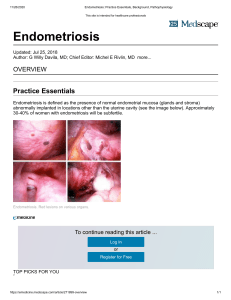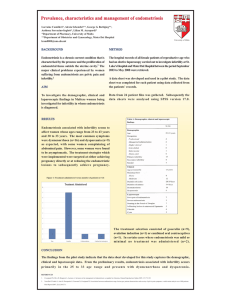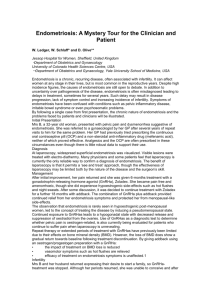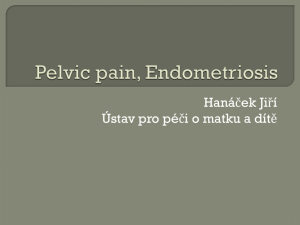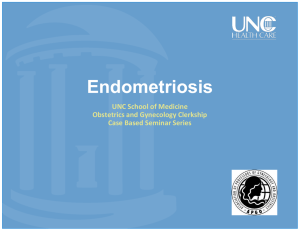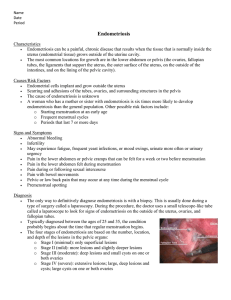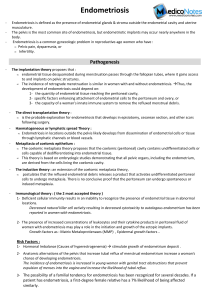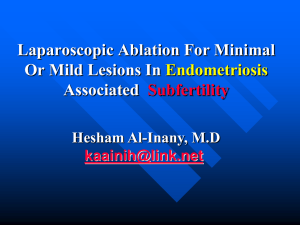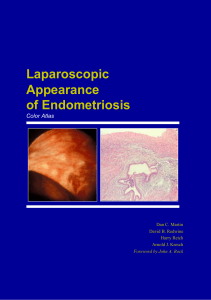pa0705006.ppt
advertisement
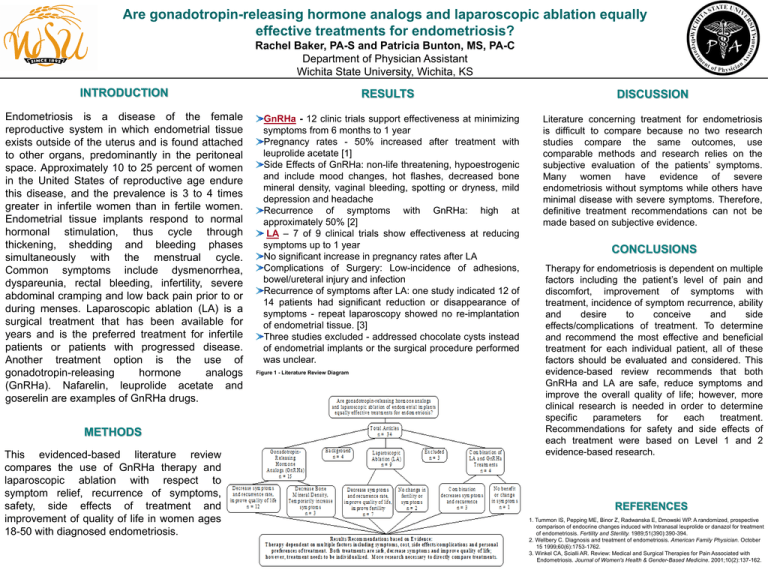
Are gonadotropin-releasing hormone analogs and laparoscopic ablation equally effective treatments for endometriosis? Rachel Baker, PA-S and Patricia Bunton, MS, PA-C Department of Physician Assistant Wichita State University, Wichita, KS INTRODUCTION Endometriosis is a disease of the female reproductive system in which endometrial tissue exists outside of the uterus and is found attached to other organs, predominantly in the peritoneal space. Approximately 10 to 25 percent of women in the United States of reproductive age endure this disease, and the prevalence is 3 to 4 times greater in infertile women than in fertile women. Endometrial tissue implants respond to normal hormonal stimulation, thus cycle through thickening, shedding and bleeding phases simultaneously with the menstrual cycle. Common symptoms include dysmenorrhea, dyspareunia, rectal bleeding, infertility, severe abdominal cramping and low back pain prior to or during menses. Laparoscopic ablation (LA) is a surgical treatment that has been available for years and is the preferred treatment for infertile patients or patients with progressed disease. Another treatment option is the use of gonadotropin-releasing hormone analogs (GnRHa). Nafarelin, leuprolide acetate and goserelin are examples of GnRHa drugs. METHODS This evidenced-based literature review compares the use of GnRHa therapy and laparoscopic ablation with respect to symptom relief, recurrence of symptoms, safety, side effects of treatment and improvement of quality of life in women ages 18-50 with diagnosed endometriosis. RESULTS GnRHa - 12 clinic trials support effectiveness at minimizing symptoms from 6 months to 1 year Pregnancy rates - 50% increased after treatment with leuprolide acetate [1] Side Effects of GnRHa: non-life threatening, hypoestrogenic and include mood changes, hot flashes, decreased bone mineral density, vaginal bleeding, spotting or dryness, mild depression and headache Recurrence of symptoms with GnRHa: high at approximately 50% [2] LA – 7 of 9 clinical trials show effectiveness at reducing symptoms up to 1 year No significant increase in pregnancy rates after LA Complications of Surgery: Low-incidence of adhesions, bowel/ureteral injury and infection Recurrence of symptoms after LA: one study indicated 12 of 14 patients had significant reduction or disappearance of symptoms - repeat laparoscopy showed no re-implantation of endometrial tissue. [3] Three studies excluded - addressed chocolate cysts instead of endometrial implants or the surgical procedure performed was unclear. Figure 1 - Literature Review Diagram DISCUSSION Literature concerning treatment for endometriosis is difficult to compare because no two research studies compare the same outcomes, use comparable methods and research relies on the subjective evaluation of the patients’ symptoms. Many women have evidence of severe endometriosis without symptoms while others have minimal disease with severe symptoms. Therefore, definitive treatment recommendations can not be made based on subjective evidence. CONCLUSIONS Therapy for endometriosis is dependent on multiple factors including the patient’s level of pain and discomfort, improvement of symptoms with treatment, incidence of symptom recurrence, ability and desire to conceive and side effects/complications of treatment. To determine and recommend the most effective and beneficial treatment for each individual patient, all of these factors should be evaluated and considered. This evidence-based review recommends that both GnRHa and LA are safe, reduce symptoms and improve the overall quality of life; however, more clinical research is needed in order to determine specific parameters for each treatment. Recommendations for safety and side effects of each treatment were based on Level 1 and 2 evidence-based research. REFERENCES 1. Tummon IS, Pepping ME, Binor Z, Radwanska E, Dmowski WP. A randomized, prospective comparison of endocrine changes induced with Intranasal leuprolide or danazol for treatment of endometriosis. Fertility and Sterility. 1989;51(390):390-394. 2. Wellbery C. Diagnosis and treatment of endometriosis. American Family Physician. October 15 1999;60(6):1753-1762. 3. Winkel CA, Scialli AR. Review: Medical and Surgical Therapies for Pain Associated with Endometriosis. Journal of Women's Health & Gender-Based Medicine. 2001;10(2):137-162.
